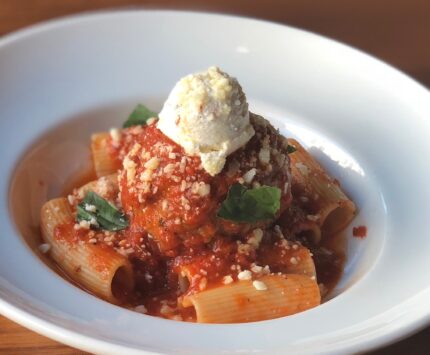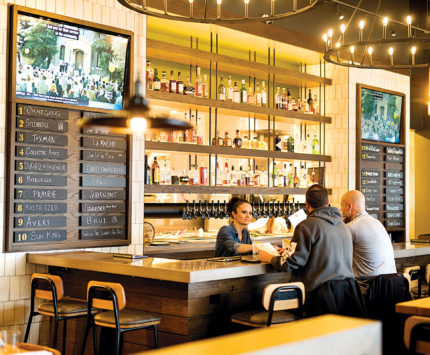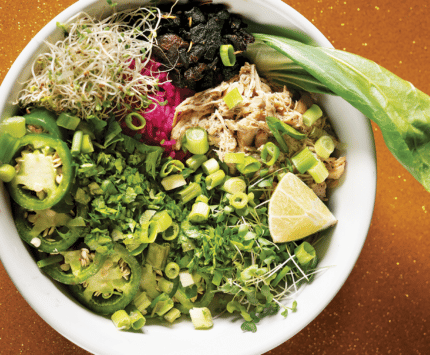Review: Nesso Coastal Italia

Whatever you think of tea-smoked duck breast stacked like masonry, or aggressively deconstructed Key lime pie, or the novelty of dining inside an Airstream-sized “nest” made of bent birch wood—you probably winced a little bit the day downtown’s stunningly innovative Cerulean closed its doors. It happened a year ago this month, and losing that glass-walled gem inside The Alexander hotel (which still seemed so young, after six years in business) felt like a knock against Indy’s delicate culinary identity. Where would we take out-of-town guests that we wanted to impress? What would become of the cool, boxy location at the corner of Delaware and South streets? More to the point, why couldn’t we have nice things?
But as quickly as Cerulean was gone, Cunningham Restaurant Group moved in to transform the neutral beach-house setting into something a little darker and sexier—and, dare I say, even nicer?
Nesso opened in August, a coastal Italian–themed restaurant from the same Indianapolis company behind fine-dining touchstones like Vida, Mesh, and Livery, as well as low-key favorites Bru Burger Bar, Union 50, and a handful of fieldstone-bedecked establishments with “Creek” in their names. The 6,000-square-foot location received a facelift that introduced a more somber, pulled-together look to match its lusty new menu direction. That meant all of Cerulean’s light blues and pale linens were replaced with a richer color scheme: plenty of espresso and slate-gray tones, and booths covered in soft Coach-purse brown leather. The bar moved from the front of the restaurant to the middle of the room, changing the way people are going to drink at Nesso—more socially, less Zen-like—and the cocktail list went perky and brief to reflect this. A spritzy Tito’s Vodka–based Italian in the Tropics and an Abe’s Sour with three bitters hearts carved into the egg-white foam headline a beverage program that gets more adventurous as it goes deeper into amari, grappa, and cordial territory and downright encyclopedic with its painstakingly categorized-by-region selection of wines.
The nest is gone, of course, because a large wooden installation piece resembling an Ikea tumbleweed just didn’t work with Cunningham’s tight-ship aesthetic. If there is a gimmicky replacement centerpiece in this new iteration, it is the one wall covered entirely in a moody floral mural, pale pink blooms against a charcoal background, practically begging to be Instagrammed behind a woman wearing a floppy brown hat.

Scallop crudo resting on an herb emulsionYou may remember him from his kitchen antics on Good Eats, where he extolled the virtues of kitchen scales and probe thermometers. Or you might know him from the more recent Cutthroat Kitchen, where he reduced contestants to cooking meals in cages with lobster claws on their hands. However you know him, Food Network host and culinary celebrity Alton Brown is bringing his zany brand of food science, music, and humor to Purdue University’s Elliott Hall of Music on Sunday, October 22, as part of his Alton Brown Live: Eat Your Science tour. For additional information and tickets, visit altonbrownlive.com.
Indianapolis Monthly: Probably more than any other TV food personality, you’ve made your career out of not just telling home cooks that they could cook but that they could understand the science and processes behind what they’re cooking. Do you get the sense that people really are cooking more in their homes because of the Food Network?
Alton Brown: It’s true that there is a much larger portion of the Food Network’s audience now that simply watches the shows and doesn’t cook the food. Back when Julia Child was first airing shows in the ’60s, it was certainly the case that a lot more of her viewers were actually cooking her food. But that’s what happens when you go from very niche television to mainstream media, as the Food Network has. Many more people are watching for the entertainment value of the cooking competitions and travel shows such as Diners, Drive-Ins, and Dives. Despite that, I’m confident that more people are cooking, because people tell me all the time that they’re cooking at home. They’re definitely more informed about food.
IM: What episodes of Good Eats do people ask you most about?
AB: You know, that’s a funny question, because it’s a total mishmash of what shows people remember the most. Of course, many people remember the hour-long shows, and a lot of people made their first turkeys because of our Thanksgiving show (“Romancing the Bird”). But beyond that, it seems that everyone has a different favorite show.
IM: Do fans bring you things from your shows for you to sign?
AB: Oh, of course. They bring me all sorts of gadgets that appeared on the show and other things they’ve concocted on their own because of watching me. Some bring their kitchen knives. Some have brought the covers off of the backs of their KitchenAid mixers. I’ve even had people bring in whole smokers for me to sign.
IM: You’ve been on the Food Network for almost two decades. How do you account for your enduring appeal?
AB: I don’t know if I’m the one to answer that, but if I could put my finger on anything, it would be that I’ve constantly evolved from the early days of Good Eats to when I was the host of Iron Chef to having my own shows such as Cutthroat Kitchen. I have seen where food television is going and have adapted what I do to what audiences want to watch. That said, I’m planning a reboot of Good Eats that will be looser, more obtuse, and more for the food enthusiast. There’s a teaser of the show on YouTube.
IM: What kinds of things does the stage show allow you to do that TV shows don’t?
AB: I often say at the beginnings of the night that my show is two and a half hours of what no one will let me do on TV. And I don’t mean just the food science stuff. My show is definitely a variety show in the old sense. It’s a mix of comedy, magic tricks, and even music. I mean, no one wants to hear Alton Brown sing on TV! Also, on TV, what I make has to be reasonable for the home chef to make as well. With the shows, what we do doesn’t have to be replicable, and we have a lot of fun with that freedom.
IM: What are some of the challenges of taking a show on the road?
AB: We’ve been touring for two years now, and we’ve learned that you have to design a show that can fit every stage. But once you’ve got the technical specs down and you’ve got a great crew to work with, there shouldn’t be all that many problems, and the shows generally go off without a hitch.
IM: What things can’t you do?
AB: Theater managers don’t like fire. They don’t want to hear about anything that has to do with fire. But that’s a limitation that has actually led to innovation. Because of it, we’ve developed the Mega Bake Oven, which is essentially a giant Easy-Bake Oven. It’s how we deal with the need for heat on the show, and it’s become a fixture on the road show.
IM: How much do you get to enjoy the food and culture of the cities you visit?
In the Cunningham ecosystem, new ventures hit the ground with some traction, aided by slick marketing and a touch of corporate-chef omniscience. Before Nesso’s debut, CRG stock chefs Carl Chambers and Layton Roberts worked to develop a menu around lush primi and secondi offerings while pastry-chef phenom Hattie McDaniel popped over from Vida to take on Nesso’s equally whimsical desserts, including a flight of mini cannoli piped with pistachio ricotta, pumpkin ricotta, and lemon-and-elderflower ricotta.
You could easily forget this dining room’s past life and anything you ever ate there the moment you bite into the scallop crudo listed near the top of Nesso’s coursed-out menu. The flesh is sliced like butter and fanned over a vibrant green herb emulsion. The flavor is clean and briny, the texture so silky. Like many of the items on Nesso’s menu, the scallop could be shared around the table as a starter. But why would you want to do that? In fact, don’t be surprised if you have a hard time stealing a bite of your neighbor’s overloaded white-bean bruschetta (presented alongside wild-mushroom and tomato pomodoro versions) or even a single gnocchi scattered on a busy plate of roasted pears and tiny chicken meatballs with crushed hazelnuts and leaves of fried sage turning simple potato dumplings into something much more complex and dramatic.
Can you believe that this trendy spot with ninja servers and valet parking offers something called prugne secche—prosciutto-wrapped prunes stuffed with soft white chèvre? The combination of textures and flavors is unbelievably delicious, the ham’s salty crunch against the desiccated fruit’s candy-like flesh and the final tart creaminess of the cheese. Roasted branzino with its charred skin and tail intact rests on a bed of tomatoes and vegetables cooked down to something like a chunky Mediterranean stew that plays up the dense meatiness of the sea bass. A 16-ounce New York strip topped with fried garlic chips and herbs gets the royal treatment of butters and reductions but still manages to taste like pure beefiness.
The pasta courses, consisting of intricate carb-based dishes downsized to be eaten before the entrée, is where Nesso pulls ahead of the stylized Italian pack and shows how the food group can be delicate and intentional, something to be savored slowly instead of wolfed down. Lemony linguini in an herb broth with clams and broccolini deserves as much praise as the airy pumpkin-and-ricotta tortelloni sauced with apple jam or the hearty calamarate with its soft pasta tubes flopping over a crush of lamb sausage, oil-cured tomatoes, golden raisins, and pine nuts.
The kitchen is confident and precise in its interpretation of Italian fine dining, even when something misses the mark, like a pitchy pan-seared salmon overburdened with hibiscus mustard and charred cabbage, or a striking but bland tonno crudo consisting of thick, bright red hunks of tuna lost in a jumble of pickled grapes and red onion. Two of the à la carte vegetable sides, broccolini + acciughe (broccolini + anchovy) and funghi + cabolo verde (mushrooms + kale) were identically salted to death and as challenging to eat as they were to order, in a restaurant that insists on calling everything by its Italian name. It’s not salmon but salmone, not tuna but tonno. Struggling through an entire script of clunky pronunciations as the server patiently corrects certainly puts you in your place, and sure, Nesso could lead with English instead of asking us to sound out ostriche con guscio right there in front of everyone. But maybe something would get lost in translation, like the sense of adventure that comes with eating not just a house salad but an insalata della casa.
It keeps us humble, and that’s a good quality to possess if we want to have nice things.






